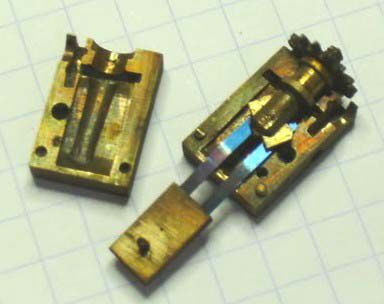Those French drum movements are about as good as it gets for any clock movement, the quality of manufacture and finish is consistently superb across the entire range whether countwheel (yours), rack striking or timepiece, and whether unsigned or bearing trademarks of Japy, Marc or Marti!
Can't argue about the 'Vallet' suspension, never bothered to research them, I only fix them when they've been inconsiderately abused (butchered), but the adjustment device is by Brocot, which is what I generally refer to them as, you'll probably find the name stamped into the gear wheel!
Hmmmmmm, Please forget an unstripped cleaning Jason, it's a shit way of cleaning a clock to be frank and what cheapskate dealers do to get one up and running sufficient to get rid of what was a non runner, even leaving the barrels out of the solution!
No matter how well you clean it, even in an ultrasonic, you will also Not get crap out of the mainspring leaves or the barrels if you do dunk them, or get the congealed oil out of the holes, and as sure as God made little apples, you'll end up with a slurry gathered in whichever part of the barrel is lowest when sitting in the tank!
You may get some of the crap running out of the lever hole in the barrel cap (slot for prying the cap off), but you will not be able to properly clean the springs or oil the mainspring!
The oil previously used in that clock will have been fish oil based (and why some stink enough to make you want to puke), ultrasonics don't get it out or off, it doesn't work on watches either, and you will always need to remove dried oil residue with a stick of pegwood before cleaning again!
Use it as a learning experience, they're not that bad to do unless you're into serious re-bushing where the top pivots are getting on for pocket watch sizes when
it all gets a bit tedious, but if you just strip it to clean and inspect and forget repairs at this stage, they're quite nice to work on!
Use a digital camera and take loads of photo's at each stage of disassembly and you wont go wrong!
Just beware on reassembly though when placing pivots, if you grip the plates too tightly together to keep those little buggers in place you've managed to capture, and you try sliding one across the plates that's slightly off it's hole, you'll probably do one of two things, (a) put a nasty scratch on the plate (not pro' and (b) snap a pivot off – mainly because the sods that tend to be out of place are the top ones on the escape wheel and fly, they're around 0.5 – 0.7mm diameter and hard as nails, they won't flex one iota and those arbours are a nightmare to pivot – Trust me on that!
and (b) snap a pivot off – mainly because the sods that tend to be out of place are the top ones on the escape wheel and fly, they're around 0.5 – 0.7mm diameter and hard as nails, they won't flex one iota and those arbours are a nightmare to pivot – Trust me on that!
Nothing to be afraid of, just make sure you let the mainsprings down first before stripping it otherwise you'll be nursing Very warm and tingly fingers for a while 
John
jason udall.


 and (b) snap a pivot off – mainly because the sods that tend to be out of place are the top ones on the escape wheel and fly, they're around 0.5 – 0.7mm diameter and hard as nails, they won't flex one iota and those arbours are a nightmare to pivot – Trust me on that!
and (b) snap a pivot off – mainly because the sods that tend to be out of place are the top ones on the escape wheel and fly, they're around 0.5 – 0.7mm diameter and hard as nails, they won't flex one iota and those arbours are a nightmare to pivot – Trust me on that!


